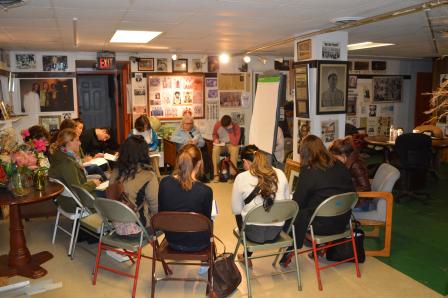EPA Researchers Share Lessons Learned from Citizen Science Research Projects
Published May 21, 2019
Environmental Health Assessments (EHAs) are used to better understand the range of possible effects of environmental factors on a community’s health and wellbeing. These assessments are defined by EPA researchers as “methodical evaluations of air, water, and soil pollution impacts on human health and the environment.”
 A citizen science based environmental health assessment of possible environmental stressors in Newport News, VA.The data and knowledge gleaned from EHAs can be applied towards increasing environmental literacy, empowering communities to implement public heath campaigns, and influencing policy decisions. One way to increase the chance of the assessment data being used by a community is to get the community involved in the assessment process through citizen science. However, these partnerships can make the research process more challenging to navigate. Without careful, ongoing communication, major disconnects can become apparent down the road.
A citizen science based environmental health assessment of possible environmental stressors in Newport News, VA.The data and knowledge gleaned from EHAs can be applied towards increasing environmental literacy, empowering communities to implement public heath campaigns, and influencing policy decisions. One way to increase the chance of the assessment data being used by a community is to get the community involved in the assessment process through citizen science. However, these partnerships can make the research process more challenging to navigate. Without careful, ongoing communication, major disconnects can become apparent down the road.
Decades of experience conducting citizen science-based EHAs brought EPA scientists to new understandings of how the power of citizen science can be harnessed to make real, positive impact for community public health. In their recently published paper, “Advice and FAQs for Citizen Science Environmental Health Assessments,” the researchers outline suggestions to prioritize clear communication between academics, government entities, and communities, and make clear from the beginning what can, and perhaps more importantly what cannot, be accomplished through research results.
In the study, researchers analyzed two case studies of citizen science-based EHAs; a citizen science air quality sensor project in Newark, NJ, and an assessment of possible environmental stressors in Newport News, VA. The two EHAs were completed using the same step-by-step process, moving from partnership formation to data collection and communication, and both kept extensive records of stakeholder meetings. Through comparison of challenges, successes, and missed opportunities, the researchers pulled out common threads that could be applied widely to future citizen science based EHAs. They distilled these into a list of “FAQs” and three primary pieces of advice:
1. Partners May Share Goals, but Not Objectives
2. Graphs Do Not Make Decisions, People Do
3. Measure Success and Manage Expectations Often
Researchers found that in some instances, the partnerships formed throughout the citizen science project are more impactful than the quantitative findings. For example, while citizen science-based air quality measurements can provide a strong basis for community level decision making, they may not translate directly into new policy or regulations. In these cases, clear communication from the start is critical to avoid false expectations.
EPA’s Tim Barzyk, a primary investigator of the Newark and Newport News EHAs and first author of “Advice and FAQs for Citizen Science Environmental Health Assessments,” notes that if researchers clearly communicate what results cannot be used for, community members tend to fill in the blank with innovative ideas for how results could be used. After a report-out to the community at the end of the Newark project, he recalls that folks began brainstorming next steps, some of which would take advantage of the new connections they had formed over the course of the EHA. He emphasizes that “It’s not so much that you collect the measurements and then you’re done. There really has to be the communication and interpretation part of it to enact some sort of progress or change on the ground – from more research, policy actions, or voluntary behavioral actions from the communities themselves.”
Citizen science-based EHAs can be a powerful catalyst for improving environmental quality and health if intentions are thoughtful and transparent from the start. EPA’s “Advice and FAQs” for citizen science EHAs can be used a starting point for effective communication between partners, allowing the public health community to take full advantage of citizen science’s potential.
Several new projects related to the “Advice and FAQs” are underway, including the development of undergraduate lesson plans where students gain first-hand experience conducting non-regulatory environmental assessments. As part of a project in Saginaw Valley, Michigan, EPA researchers and partners in EPA Region 5 are also developing a database of environmental actions that address health effects from different pollutants, ranging from implementing new policies to voluntary changes in personal behavior. The interactive database will help communities address the question of “Now what?” after initial citizen science-based measurements are complete.
You can find the article “Advice and FAQs for Citizen Science Environmental Health Assessments” here. The supplemental materials are also worth reading -- they contain annotated notes for each of the frequently asked questions.
Read more about the EPA’s Air Sensor Citizen Science Toolbox.
Citations:
Barzyk, T.M., Huang, H., Williams, R., Kaufman, A., Essoka, J. (2018). Advice and Frequently Asked Questions (FAQs) for Citizen-Science Environmental Health Assessments. International Journal of Environmental Research and Public Health, 15(5). doi: 10.3390/ijerph15050960.
